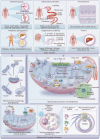Targeting mitochondrial quality control: new therapeutic strategies for major diseases
- PMID: 39164792
- PMCID: PMC11337860
- DOI: 10.1186/s40779-024-00556-1
Targeting mitochondrial quality control: new therapeutic strategies for major diseases
Abstract
Mitochondria play a crucial role in maintaining the normal physiological state of cells. Hence, ensuring mitochondrial quality control is imperative for the prevention and treatment of numerous diseases. Previous reviews on this topic have however been inconsistencies and lack of systematic organization. Therefore, this review aims to provide a comprehensive and systematic overview of mitochondrial quality control and explore the possibility of targeting the same for the treatment of major diseases. This review systematically summarizes three fundamental characteristics of mitochondrial quality control, including mitochondrial morphology and dynamics, function and metabolism, and protein expression and regulation. It also extensively examines how imbalances in mitochondrial quality are linked to major diseases, such as ischemia-hypoxia, inflammatory disorders, viral infections, metabolic dysregulations, degenerative conditions, and tumors. Additionally, the review explores innovative approaches to target mitochondrial quality control, including using small molecule drugs that regulate critical steps in maintaining mitochondrial quality, nanomolecular materials designed for precise targeting of mitochondria, and novel cellular therapies, such as vesicle therapy and mitochondrial transplantation. This review offers a novel perspective on comprehending the shared mechanisms underlying the occurrence and progression of major diseases and provides theoretical support and practical guidance for the clinical implementation of innovative therapeutic strategies that target mitochondrial quality control for treating major diseases.
Keywords: Major diseases; Mitochondrial quality control; Mitochondrial targeted therapy.
© 2024. The Author(s).
Conflict of interest statement
The authors declare that they have no competing interests.
Figures



Similar articles
-
Mitochondrial biogenesis: pharmacological approaches.Curr Pharm Des. 2014;20(35):5507-9. doi: 10.2174/138161282035140911142118. Curr Pharm Des. 2014. PMID: 24606795
-
Mediators of mitophagy that regulate mitochondrial quality control play crucial role in diverse pathophysiology.Cell Biol Toxicol. 2021 Jun;37(3):333-366. doi: 10.1007/s10565-020-09561-1. Epub 2020 Oct 17. Cell Biol Toxicol. 2021. PMID: 33067701 Review.
-
The involvement of the mitochondrial membrane in drug delivery.Acta Biomater. 2024 Mar 1;176:28-50. doi: 10.1016/j.actbio.2024.01.027. Epub 2024 Jan 26. Acta Biomater. 2024. PMID: 38280553 Review.
-
Strategic disruption of cancer's powerhouse: precise nanomedicine targeting of mitochondrial metabolism.J Nanobiotechnology. 2024 Jun 8;22(1):318. doi: 10.1186/s12951-024-02585-3. J Nanobiotechnology. 2024. PMID: 38849914 Free PMC article. Review.
-
Mitochondrial transfer - a novel promising approach for the treatment of metabolic diseases.Front Endocrinol (Lausanne). 2024 Jan 19;14:1346441. doi: 10.3389/fendo.2023.1346441. eCollection 2023. Front Endocrinol (Lausanne). 2024. PMID: 38313834 Free PMC article. Review.
Cited by
-
The multifaceted role of mitochondria in cardiac function: insights and approaches.Cell Commun Signal. 2024 Oct 29;22(1):525. doi: 10.1186/s12964-024-01899-x. Cell Commun Signal. 2024. PMID: 39472951 Free PMC article. Review.
-
Exploring the Mechanism of Ferroptosis Induction by Sappanone A in Cancer: Insights into the Mitochondrial Dysfunction Mediated by NRF2/xCT/GPX4 Axis.Int J Biol Sci. 2024 Sep 23;20(13):5145-5161. doi: 10.7150/ijbs.96748. eCollection 2024. Int J Biol Sci. 2024. PMID: 39430236 Free PMC article.
References
Publication types
MeSH terms
Grants and funding
LinkOut - more resources
Full Text Sources

